Chapter 3.4: The Limit Laws
Learning Objectives
- Recognize the basic limit laws.
- Use the limit laws to evaluate the limit of a function.
- Evaluate the limit of a function by factoring.
- Use the limit laws to evaluate the limit of a polynomial or rational function.
- Evaluate the limit of a function by factoring or by using conjugates.
- Evaluate the limit of a function by using the squeeze theorem.
In the previous section, we evaluated limits by looking at graphs or by constructing a table of values. In this section, we establish laws for calculating limits and learn how to apply these laws. In the Student Project at the end of this section, you have the opportunity to apply these limit laws to derive the formula for the area of a circle by adapting a method devised by the Greek mathematician Archimedes. We begin by restating two useful limit results from the previous section. These two results, together with the limit laws, serve as a foundation for calculating many limits.
Evaluating Limits with the Limit Laws
The first two limit laws were stated in (Figure) and we repeat them here. These basic results, together with the other limit laws, allow us to evaluate limits of many algebraic functions.
Basic Limit Results
For any real number ![]() and any constant
and any constant ![]() ,
,
Evaluating a Basic Limit
Evaluate each of the following limits using (Figure).
Solution
- The limit of
 as
as  approaches
approaches  is
is  :
:  .
. - The limit of a constant is that constant:
 .
.
We now take a look at the limit laws, the individual properties of limits. The proofs that these laws hold are omitted here.
Limit Laws
Let ![]() and
and ![]() be defined for all
be defined for all ![]() over some open interval containing
over some open interval containing ![]() . Assume that
. Assume that ![]() and
and ![]() are real numbers such that
are real numbers such that ![]() and
and ![]() . Let
. Let ![]() be a constant. Then, each of the following statements holds:
be a constant. Then, each of the following statements holds:
Sum law for limits: ![]()
Difference law for limits: ![]()
Constant multiple law for limits: ![]()
Product law for limits: ![]()
Quotient law for limits: ![]() for
for ![]()
Power law for limits: ![]() for every positive integer
for every positive integer ![]() .
.
Root law for limits: ![]() for all
for all ![]() if
if ![]() is odd and for
is odd and for ![]() if
if ![]() is even.
is even.
We now practice applying these limit laws to evaluate a limit.
Evaluating a Limit Using Limit Laws
Use the limit laws to evaluate ![]() .
.
Solution
Let’s apply the limit laws one step at a time to be sure we understand how they work. We need to keep in mind the requirement that, at each application of a limit law, the new limits must exist for the limit law to be applied.

Using Limit Laws Repeatedly
Use the limit laws to evaluate ![]() .
.
Solution
To find this limit, we need to apply the limit laws several times. Again, we need to keep in mind that as we rewrite the limit in terms of other limits, each new limit must exist for the limit law to be applied.

Use the limit laws to evaluate ![]() . In each step, indicate the limit law applied.
. In each step, indicate the limit law applied.
Solution
![]()
Limits of Polynomial and Rational Functions
By now you have probably noticed that, in each of the previous examples, it has been the case that ![]() . This is not always true, but it does hold for all polynomials for any choice of
. This is not always true, but it does hold for all polynomials for any choice of ![]() and for all rational functions at all values of
and for all rational functions at all values of ![]() for which the rational function is defined.
for which the rational function is defined.
Limits of Polynomial and Rational Functions
Let ![]() and
and ![]() be polynomial functions. Let
be polynomial functions. Let ![]() be a real number. Then,
be a real number. Then,
To see that this theorem holds, consider the polynomial ![]() . By applying the sum, constant multiple, and power laws, we end up with
. By applying the sum, constant multiple, and power laws, we end up with

It now follows from the quotient law that if ![]() and
and ![]() are polynomials for which
are polynomials for which ![]() , then
, then
(Figure) applies this result.
Evaluating a Limit of a Rational Function
Evaluate the ![]() .
.
Solution
Since 3 is in the domain of the rational function ![]() , we can calculate the limit by substituting 3 for
, we can calculate the limit by substituting 3 for ![]() into the function. Thus,
into the function. Thus,
Additional Limit Evaluation Techniques
As we have seen, we may evaluate easily the limits of polynomials and limits of some (but not all) rational functions by direct substitution. However, as we saw in the introductory section on limits, it is certainly possible for ![]() to exist when
to exist when ![]() is undefined. The following observation allows us to evaluate many limits of this type:
is undefined. The following observation allows us to evaluate many limits of this type:
If for all ![]() over some open interval containing
over some open interval containing ![]() , then
, then ![]() .
.
To understand this idea better, consider the limit ![]() .
.
The function

and the function ![]() are identical for all values of
are identical for all values of ![]() The graphs of these two functions are shown in (Figure).
The graphs of these two functions are shown in (Figure).

 and
and  are identical for all
are identical for all  . Their limits at 1 are equal.
. Their limits at 1 are equal.We see that

The limit has the form ![]() , where
, where ![]() and
and ![]() . (In this case, we say that
. (In this case, we say that ![]() has the indeterminate form 0/0.) The following Problem-Solving Strategy provides a general outline for evaluating limits of this type.
has the indeterminate form 0/0.) The following Problem-Solving Strategy provides a general outline for evaluating limits of this type.
Problem-Solving Strategy: Calculating a Limit When  has the Indeterminate Form 0/0
has the Indeterminate Form 0/0
- First, we need to make sure that our function has the appropriate form and cannot be evaluated immediately using the limit laws.
- We then need to find a function that is equal to
 for all
for all  over some interval containing
over some interval containing  . To do this, we may need to try one or more of the following steps:
. To do this, we may need to try one or more of the following steps:
- If
 and
and  are polynomials, we should factor each function and cancel out any common factors.
are polynomials, we should factor each function and cancel out any common factors. - If the numerator or denominator contains a difference involving a square root, we should try multiplying the numerator and denominator by the conjugate of the expression involving the square root.
- If
 is a complex fraction, we begin by simplifying it.
is a complex fraction, we begin by simplifying it.
- If
- Last, we apply the limit laws.
The next examples demonstrate the use of this Problem-Solving Strategy. (Figure) illustrates the factor-and-cancel technique; (Figure) shows multiplying by a conjugate. In (Figure), we look at simplifying a complex fraction.
Evaluating a Limit by Factoring and Canceling
Evaluate ![]() .
.
Solution
Step 1. The function ![]() is undefined for
is undefined for ![]() . In fact, if we substitute 3 into the function we get 0/0, which is undefined. Factoring and canceling is a good strategy:
. In fact, if we substitute 3 into the function we get 0/0, which is undefined. Factoring and canceling is a good strategy:
Step 2. For all ![]() . Therefore,
. Therefore,
Step 3. Evaluate using the limit laws:
Evaluating a Limit by Multiplying by a Conjugate
Evaluate ![]() .
.
Solution
Step 1. ![]() has the form 0/0 at −1. Let’s begin by multiplying by
has the form 0/0 at −1. Let’s begin by multiplying by ![]() , the conjugate of
, the conjugate of ![]() , on the numerator and denominator:
, on the numerator and denominator:
Step 2. We then multiply out the numerator. We don’t multiply out the denominator because we are hoping that the ![]() in the denominator cancels out in the end:
in the denominator cancels out in the end:
Step 3. Then we cancel:
Step 4. Last, we apply the limit laws:
Evaluating a Limit by Simplifying a Complex Fraction
Evaluate ![]() .
.
Solution
Step 1. ![]() has the form 0/0 at 1. We simplify the algebraic fraction by multiplying by
has the form 0/0 at 1. We simplify the algebraic fraction by multiplying by ![]() :
:
Step 2. Next, we multiply through the numerators. Do not multiply the denominators because we want to be able to cancel the factor ![]() :
:
Step 3. Then, we simplify the numerator:
Step 4. Now we factor out −1 from the numerator:
Step 5. Then, we cancel the common factors of ![]() :
:
Step 6. Last, we evaluate using the limit laws:
(Figure) does not fall neatly into any of the patterns established in the previous examples. However, with a little creativity, we can still use these same techniques.
Evaluating a Limit When the Limit Laws Do Not Apply
Evaluate ![]() .
.
Solution
Both ![]() and
and ![]() fail to have a limit at zero. Since neither of the two functions has a limit at zero, we cannot apply the sum law for limits; we must use a different strategy. In this case, we find the limit by performing addition and then applying one of our previous strategies. Observe that
fail to have a limit at zero. Since neither of the two functions has a limit at zero, we cannot apply the sum law for limits; we must use a different strategy. In this case, we find the limit by performing addition and then applying one of our previous strategies. Observe that

Thus,

Evaluate ![]() .
.
Solution
![]()
Hint
Use the same technique as (Figure). Don’t forget to factor ![]() before getting a common denominator.
before getting a common denominator.
Let’s now revisit one-sided limits. Simple modifications in the limit laws allow us to apply them to one-sided limits. For example, to apply the limit laws to a limit of the form ![]() , we require the function
, we require the function ![]() to be defined over an open interval of the form
to be defined over an open interval of the form ![]() ; for a limit of the form
; for a limit of the form ![]() , we require the function
, we require the function ![]() to be defined over an open interval of the form
to be defined over an open interval of the form ![]() . (Figure) illustrates this point.
. (Figure) illustrates this point.
Evaluating a One-Sided Limit Using the Limit Laws
Evaluate each of the following limits, if possible.
Solution
(Figure) illustrates the function ![]() and aids in our understanding of these limits.
and aids in our understanding of these limits.
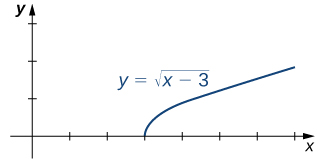
 .
.- The function
 is defined over the interval
is defined over the interval  . Since this function is not defined to the left of 3, we cannot apply the limit laws to compute
. Since this function is not defined to the left of 3, we cannot apply the limit laws to compute  . In fact, since
. In fact, since  is undefined to the left of 3,
is undefined to the left of 3,  does not exist.
does not exist. - Since
 is defined to the right of 3, the limit laws do apply to
is defined to the right of 3, the limit laws do apply to  . By applying these limit laws we obtain
. By applying these limit laws we obtain  .
.
In (Figure) we look at one-sided limits of a piecewise-defined function and use these limits to draw a conclusion about a two-sided limit of the same function.
Evaluating a Two-Sided Limit Using the Limit Laws
For  evaluate each of the following limits:
evaluate each of the following limits:
Solution
(Figure) illustrates the function ![]() and aids in our understanding of these limits.
and aids in our understanding of these limits.
https://s3-us-west-2.amazonaws.com/courses-images/wp-content/uploads/sites/2332/2018/01/11203424/CNX_Calc_Figure_02_03_003.jpg
- Since
 for all
for all  in
in  , replace
, replace  in the limit with
in the limit with  and apply the limit laws:
and apply the limit laws:
 .
. - Since
 for all
for all  in
in  , replace
, replace  in the limit with
in the limit with  and apply the limit laws:
and apply the limit laws:
 .
. - Since
 and
and  , we conclude that
, we conclude that  does not exist.
does not exist.
We now turn our attention to evaluating a limit of the form ![]() , where
, where ![]() , where
, where ![]() and
and ![]() . That is,
. That is, ![]() has the form
has the form ![]() at
at ![]() .
.
Evaluating a Limit of the Form  Using the Limit Laws
Using the Limit Laws
Evaluate ![]() .
.
Solution
Step 1. After substituting in ![]() , we see that this limit has the form
, we see that this limit has the form ![]() . That is, as
. That is, as ![]() approaches 2 from the left, the numerator approaches −1 and the denominator approaches 0. Consequently, the magnitude of
approaches 2 from the left, the numerator approaches −1 and the denominator approaches 0. Consequently, the magnitude of ![]() becomes infinite. To get a better idea of what the limit is, we need to factor the denominator:
becomes infinite. To get a better idea of what the limit is, we need to factor the denominator:
Step 2. Since ![]() is the only part of the denominator that is zero when 2 is substituted, we then separate
is the only part of the denominator that is zero when 2 is substituted, we then separate ![]() from the rest of the function:
from the rest of the function:
Step 3. ![]() and
and ![]() . Therefore, the product of
. Therefore, the product of ![]() and
and ![]() has a limit of
has a limit of ![]() :
:
The Squeeze Theorem
The techniques we have developed thus far work very well for algebraic functions, but we are still unable to evaluate limits of very basic trigonometric functions. The next theorem, called the squeeze theorem, proves very useful for establishing basic trigonometric limits. This theorem allows us to calculate limits by “squeezing” a function, with a limit at a point ![]() that is unknown, between two functions having a common known limit at
that is unknown, between two functions having a common known limit at ![]() . (Figure) illustrates this idea.
. (Figure) illustrates this idea.
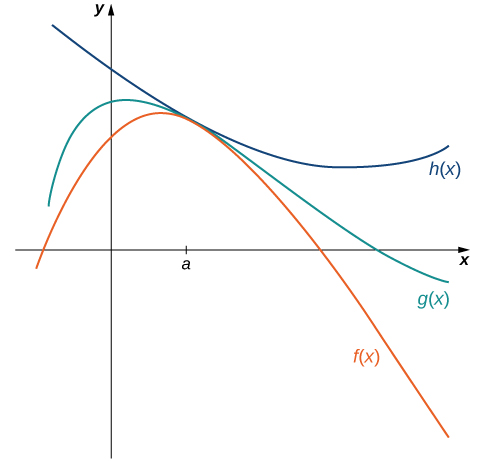
 and
and  .
.The Squeeze Theorem
Let ![]() , and
, and ![]() be defined for all
be defined for all ![]() over an open interval containing
over an open interval containing ![]() . If
. If
for all ![]() in an open interval containing
in an open interval containing ![]() and
and
where ![]() is a real number, then
is a real number, then ![]() .
.
Applying the Squeeze Theorem
Apply the Squeeze Theorem to evaluate ![]() .
.
Solution
Because ![]() for all
for all ![]() , we have
, we have ![]() for
for ![]() and
and ![]() for
for ![]() (if
(if ![]() is negative the direction of the inequalities changes when we multiply). Since
is negative the direction of the inequalities changes when we multiply). Since ![]() , from the Squeeze Theorem we obtain
, from the Squeeze Theorem we obtain ![]() . The graphs of
. The graphs of ![]() , and
, and ![]() are shown in (Figure).
are shown in (Figure).

Use the Squeeze Theorem to evaluate ![]() .
.
Solution
0
Hint
Use the fact that ![]() to help you find two functions such that
to help you find two functions such that ![]() is squeezed between them.
is squeezed between them.
We now use the Squeeze Theorem to tackle several very important limits. Although this discussion is somewhat lengthy, these limits prove invaluable for the development of the material in both the next section and the next chapter. The first of these limits is ![]() . Consider the unit circle shown in (Figure). In the figure, we see that
. Consider the unit circle shown in (Figure). In the figure, we see that ![]() is the
is the ![]() -coordinate on the unit circle and it corresponds to the line segment shown in blue. The radian measure of angle θ is the length of the arc it subtends on the unit circle. Therefore, we see that for
-coordinate on the unit circle and it corresponds to the line segment shown in blue. The radian measure of angle θ is the length of the arc it subtends on the unit circle. Therefore, we see that for ![]() .
.
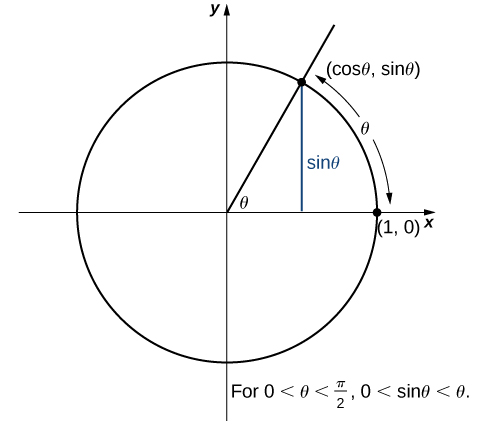
Because ![]() and
and ![]() , by using the Squeeze Theorem we conclude that
, by using the Squeeze Theorem we conclude that
To see that ![]() as well, observe that for
as well, observe that for ![]() and hence,
and hence, ![]() . Consequently,
. Consequently, ![]() It follows that
It follows that ![]() . An application of the Squeeze Theorem produces the desired limit. Thus, since
. An application of the Squeeze Theorem produces the desired limit. Thus, since ![]() and
and ![]() ,
,
Next, using the identity ![]() for
for ![]() , we see that
, we see that
We now take a look at a limit that plays an important role in later chapters—namely, ![]() . To evaluate this limit, we use the unit circle in (Figure). Notice that this figure adds one additional triangle to (Figure). We see that the length of the side opposite angle
. To evaluate this limit, we use the unit circle in (Figure). Notice that this figure adds one additional triangle to (Figure). We see that the length of the side opposite angle ![]() in this new triangle is
in this new triangle is ![]() . Thus, we see that for
. Thus, we see that for ![]() .
.
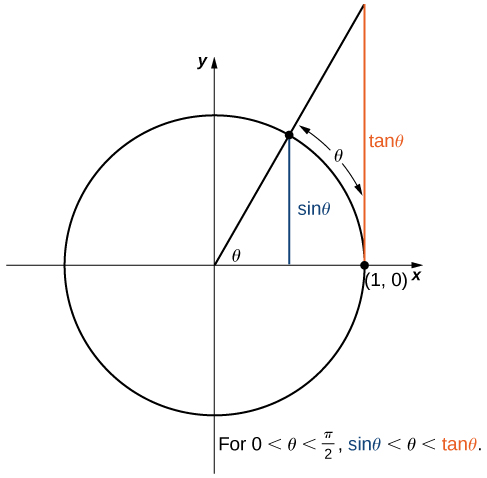
By dividing by ![]() in all parts of the inequality, we obtain
in all parts of the inequality, we obtain
Equivalently, we have
Since ![]() , we conclude that
, we conclude that ![]() . By applying a manipulation similar to that used in demonstrating that
. By applying a manipulation similar to that used in demonstrating that ![]() , we can show that
, we can show that ![]() . Thus,
. Thus,
In (Figure) we use this limit to establish ![]() . This limit also proves useful in later chapters.
. This limit also proves useful in later chapters.
Evaluating an Important Trigonometric Limit
Evaluate ![]() .
.
Solution
In the first step, we multiply by the conjugate so that we can use a trigonometric identity to convert the cosine in the numerator to a sine:
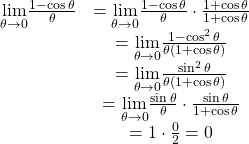
Therefore,
Evaluate ![]() .
.
Solution
0
Hint
Multiply numerator and denominator by ![]() .
.
Deriving the Formula for the Area of a Circle
Some of the geometric formulas we take for granted today were first derived by methods that anticipate some of the methods of calculus. The Greek mathematician Archimedes (ca. 287−212 BCE) was particularly inventive, using polygons inscribed within circles to approximate the area of the circle as the number of sides of the polygon increased. He never came up with the idea of a limit, but we can use this idea to see what his geometric constructions could have predicted about the limit.
We can estimate the area of a circle by computing the area of an inscribed regular polygon. Think of the regular polygon as being made up of ![]() triangles. By taking the limit as the vertex angle of these triangles goes to zero, you can obtain the area of the circle. To see this, carry out the following steps:
triangles. By taking the limit as the vertex angle of these triangles goes to zero, you can obtain the area of the circle. To see this, carry out the following steps:
- Express the height
 and the base
and the base  of the isosceles triangle in (Figure) in terms of
of the isosceles triangle in (Figure) in terms of  and
and  .
.

Figure 8. - Using the expressions that you obtained in step 1, express the area of the isosceles triangle in terms of
 and
and  .
.
(Substitute for
for  in your expression.)
in your expression.) - If an
 -sided regular polygon is inscribed in a circle of radius
-sided regular polygon is inscribed in a circle of radius  , find a relationship between
, find a relationship between  and
and  . Solve this for
. Solve this for  . Keep in mind there are
. Keep in mind there are  radians in a circle. (Use radians, not degrees.)
radians in a circle. (Use radians, not degrees.) - Find an expression for the area of the
 -sided polygon in terms of
-sided polygon in terms of  and
and  .
. - To find a formula for the area of the circle, find the limit of the expression in step 4 as
 goes to zero. (Hint:
goes to zero. (Hint:  .)
.)
The technique of estimating areas of regions by using polygons is revisited in Introduction to Integration.
Key Concepts
- The limit laws allow us to evaluate limits of functions without having to go through step-by-step processes each time.
- For polynomials and rational functions,
 .
. - You can evaluate the limit of a function by factoring and canceling, by multiplying by a conjugate, or by simplifying a complex fraction.
- The Squeeze Theorem allows you to find the limit of a function if the function is always greater than one function and less than another function with limits that are known.
Key Equations
- Basic Limit Results


- Important Limits




In the following exercises, use the limit laws to evaluate each limit. Justify each step by indicating the appropriate limit law(s).
1. ![]()
Solution
Use constant multiple law and difference law: ![]()
2. ![]()
3. ![]()
Solution
Use root law: ![]()
4. ![]()
In the following exercises, use direct substitution to evaluate each limit.
5. ![]()
Solution
49
6. ![]()
7. ![]()
Solution
1
8. ![]()
9. ![]()
Solution
![]()
10. ![]()
In the following exercises, use direct substitution to show that each limit leads to the indeterminate form 0/0. Then, evaluate the limit.
11. ![]()
Solution
![]() ; then,
; then, ![]()
12. ![]()
13. ![]()
Solution
![]() ; then,
; then, ![]()
14. ![]()
15. ![]()
Solution
![]() ; then,
; then, ![]()
16. ![]() , where
, where ![]() is a real-valued constant
is a real-valued constant
17. ![]()
Solution
![]() ; then,
; then, ![]() .
.
18. ![]()
19. ![]()
Solution
![]() ; then,
; then, ![]()
20. ![]()
In the following exercises, use direct substitution to obtain an undefined expression. Then, use the method of (Figure) to simplify the function to help determine the limit.
21. ![]()
Solution
![]()
22. ![]()
23. ![]()
Solution
![]()
24. ![]()
In the following exercises, assume that ![]() , and
, and ![]() . Use these three facts and the limit laws to evaluate each limit.
. Use these three facts and the limit laws to evaluate each limit.
25. ![]()
Solution
![]()
26. ![]()
27. ![]()
Solution
![]()
28. ![]()
29. ![]()
Solution
![]()
30. ![]()
31. ![]()
Solution
![]() .
.
32. ![]()
In the following exercises, use a calculator to draw the graph of each piecewise-defined function and study the graph to evaluate the given limits.
33. [T] 
Solution

a. 9; b. 7
34. [T] 
35. [T] 
Solution

a. 1; b. 1
In the following exercises, use the following graphs and the limit laws to evaluate each limit.
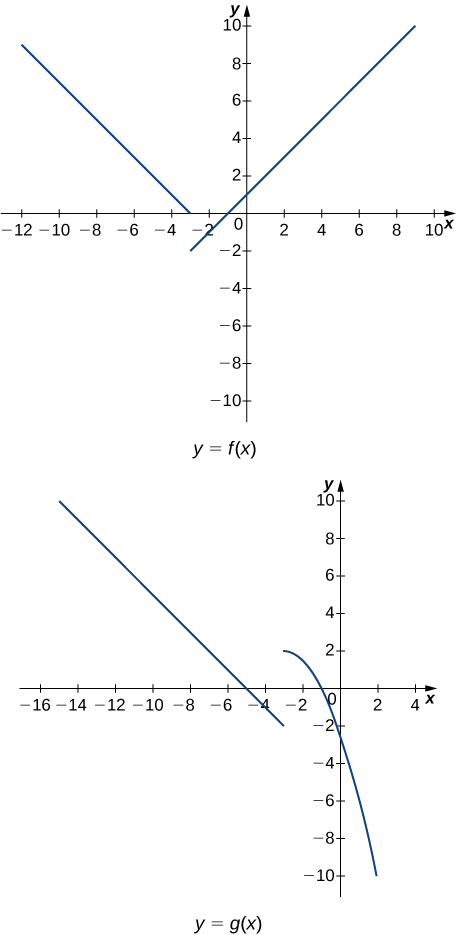
36. ![]()
37. ![]()
Solution
![]()
38. ![]()
39. ![]()
Solution
![]()
40. ![]()
41. ![]()
Show Solution
![]()
42. ![]()
43. ![]()
Solution
![]()
For the following problems, evaluate the limit using the Squeeze Theorem. Use a calculator to graph the functions ![]() , and
, and ![]() when possible.
when possible.
44. [T] True or False? If ![]() , then
, then ![]() .
.
45. [T] ![]()
Solution
The limit is zero.
![The graph of three functions over the domain [-1,1], colored red, green, and blue as follows: red: theta^2, green: theta^2 * cos (1/theta), and blue: - (theta^2). The red and blue functions open upwards and downwards respectively as parabolas with vertices at the origin. The green function is trapped between the two.](https://s3-us-west-2.amazonaws.com/courses-images/wp-content/uploads/sites/2332/2018/01/11203457/CNX_Calc_Figure_02_03_206.jpg)
46. ![]() , where
, where 
47. [T] In physics, the magnitude of an electric field generated by a point charge at a distance ![]() in vacuum is governed by Coulomb’s law:
in vacuum is governed by Coulomb’s law: ![]() , where
, where ![]() represents the magnitude of the electric field,
represents the magnitude of the electric field, ![]() is the charge of the particle,
is the charge of the particle, ![]() is the distance between the particle and where the strength of the field is measured, and
is the distance between the particle and where the strength of the field is measured, and ![]() is Coulomb’s constant:
is Coulomb’s constant: ![]() .
.
- Use a graphing calculator to graph
 given that the charge of the particle is
given that the charge of the particle is  .
. - Evaluate
 . What is the physical meaning of this quantity? Is it physically relevant? Why are you evaluating from the right?
. What is the physical meaning of this quantity? Is it physically relevant? Why are you evaluating from the right?
Solution
a.
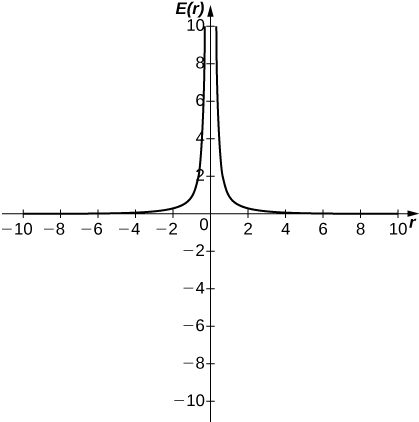
b. ![]() . The magnitude of the electric field as you approach the particle
. The magnitude of the electric field as you approach the particle ![]() becomes infinite. It does not make physical sense to evaluate negative distance.
becomes infinite. It does not make physical sense to evaluate negative distance.
48. [T] The density of an object is given by its mass divided by its volume: ![]() .
.
- Use a calculator to plot the volume as a function of density
 , assuming you are examining something of mass 8 kg (
, assuming you are examining something of mass 8 kg (  ).
). - Evaluate
 and explain the physical meaning.
and explain the physical meaning.
Glossary
- constant multiple law for limits
- the limit law

- difference law for limits
- the limit law

- limit laws
- the individual properties of limits; for each of the individual laws, let
 and
and  be defined for all
be defined for all  over some open interval containing
over some open interval containing  ; assume that
; assume that  and
and  are real numbers so that
are real numbers so that  and
and  ; let
; let  be a constant
be a constant
- power law for limits
- the limit law
 for every positive integer
for every positive integer 
- product law for limits
- the limit law

- quotient law for limits
- the limit law
 for
for 
- root law for limits
- the limit law
![Rendered by QuickLaTeX.com \underset{x\to a}{\lim}\sqrt[n]{f(x)}=\sqrt[n]{\underset{x\to a}{\lim}f(x)}=\sqrt[n]{L}](https://ecampusontario.pressbooks.pub/app/uploads/quicklatex/quicklatex.com-f4753c654e594bd43d8e204b15bac170_l3.png) for all
for all  if
if  is odd and for
is odd and for  if
if  is even
is even
- Squeeze Theorem
- states that if
 for all
for all  over an open interval containing
over an open interval containing  and
and  where
where  is a real number, then
is a real number, then 
- sum law for limits
- The limit law


 and evaluate
and evaluate 

Hint
Begin by applying the product law.